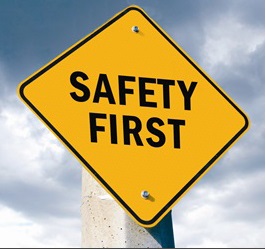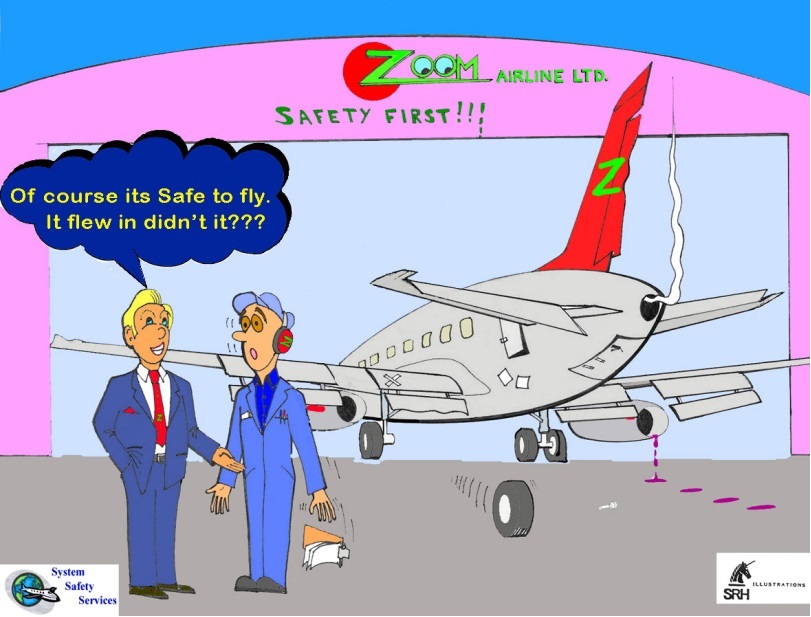Every company will tell you they have a Safety Culture, but do they and how do you know?
A Safety culture is much more than the “Safety First” sign hanging up over the door. That sign means nothing and is pure unadulterated “Bull Pucky”. If it were true, all aircraft would sit on the ground and no one would touch them. Only then could they be considered 100% Safe.

A company needs to make a profit in order to survive. Thus, profit and survival come first and one can hope that Safety comes a close second. Without profit there is soon no need for Safety, as the company will cease to exist.
The “Safety First” sign comes with some very small print, like you see on some “too good to be true” deals. I’ve seen on TV recently, ads for high speed cable internet for only $5.00 per month. In that very small print you will find that price is for 6 months after which you will pay $49.99 per month on a two year contract when bundled with a $79.99 TV service and a $24.99 phone service. The small print on the “Safety First” sign says, “…unless it costs money.” The more expensive a proposed Safety fix is going to be, the less likely it will happen, because it interferes with the real “first” – Profit. So all those signs you see should really say “Safety; a very close second to profit”, if they were honest.
A Safety Culture is hard to measure, but you’ll soon know it after you’ve worked in it for a while. The odds of being killed in an aircraft accident vary from 1 in 260,000 flights (parts of Africa) to 1 in 11,000,000 flights. (North America and other Western countries). What makes this huge difference? Simple: The Safety Culture.
What is this Safety Culture? Here is one person’s interpretation of a Safety Culture:
“The product of individual and group values, attitudes, perceptions, competencies, and patterns of behavior that determine the commitment to, and the style and proficiency of, an organization’s health and Safety management.”
Here is what I think a Safety Culture is.
A true Safety Culture is where:
- Safety is treated seriously by the management
- all believe that Safety does not have to come at the cost of productivity
- Safety is an integral part of the way the company operates
- all company employees are trained and encouraged to think and work Safely at all times
- Safety goals are set and all work toward their achievement
Do You Work in a Safety Culture?
The following questions have been adapted from my good friend Professor James Reason and are intended to help determine if your organization has a Safety oriented culture.
Where does your Company fit in? Answer these questions and find out. If you don’t know the answer, give it a 0.
Give each question a rating by circling 0, 5 or 10 according to the following scoring:
0 5 10
No, not my Sometimes Yes, This is
Company my Company my Company
- MINDFUL OF DANGER: I believe our Company’s management is very mindful of the human and organizational factors that can endanger our operations.
0 5 10
- MISSION STATEMENT: Our Company illustrates its commitment to Safety in its mission statement that includes the call to operate Safely.
0 5 10
- SAFETY POLICY: Our Company has a Safety Policy that is readily visible to all and spells out everyone’s responsibilities toward Safety.
0 5 10
- ACCEPTS SETBACKS: I believe our Company’s management understands and accepts occasional setbacks and nasty surprises as inevitable. They realize that staff will make errors and trains them to avoid, or detect and recover from them.
0 5 10
- COMMITTED: I believe our Company’s management are genuinely committed to aviation Safety and provide adequate resources to serve this end.
0 5 10
- HF TRAINING: In our Company, all employees, including management are trained in human factors in order to learn how to avoid the error they never intend to make.
0 5 10
- EVENTS REVIEWED: In our Company past events are thoroughly reviewed at top level meetings and the lessons learned are implemented as Company-wide reforms, not local repairs.
0 5 10
- IMPROVED DEFENCE: After an incident in our Company, the primary aim of management is to identify the failed system defenses and improve them, rather than to seek to divert responsibility to the incident individuals.
0 5 10
- DATA: I believe our management recognizes that effective management of Safety, just like any other management process, depends critically on the collection, analysis and dissemination of relevant information.
0 5 10
- HEALTH CHECKS: In our Company, management adopts a proactive stance towards Safety. That is, it does some or all of the following:
- a) takes steps to identify recurrent error traps and removes them;
- b) strives to eliminate the workplace and organizational factors likely to provoke error;
- c) brainstorms new scenarios of failure; and/or
- d) conducts regular “health checks” on the organizational process known to contribute to incidents.
0 5 10
- STAFF ATTENDS SAFETY MEETINGS: In our Company, staff attends meetings relating to Safety from a wide variety of departments and levels.
0 5 10
- INFORMATION: Our Company provides feedback to all employees when an error is made and furnishes ways to avoid repeating the error. It keeps us informed of areas we can improve on as well as our successes.
0 5 10
- MONEY VS. SAFETY: I believe our Company recognizes that commercial goals and Safety issues can come into conflict and have placed measures to recognize and resolve such conflicts in an effective and transparent manner.
0 5 10
- REPORTING ENCOURAGED: I believe our Company has policies in place that encourage everyone to report Safety-related issues (one of the defining characteristics of a pathological culture is that Safety messengers are “shot” and whistleblowers dismissed or discredited).
0 5 10
- REPORTING TRUST: My fellow employees and I trust our management and have reported human errors over the past 12 months.
0 5 10
- ADMINISTRATIVE POLICY: Our Company has an Administrative Policy that makes clear the Company’s stance regarding qualified indemnity against sanctions, confidentiality, and the organizational separation of the data-collecting department from those involved in disciplinary proceedings.
0 5 10
- BLAME: I believe my Company’s Administrative Policy is based on an agreed (i.e. negotiated) distinction between acceptable and unacceptable behaviour. It is recognized by all staff that a small proportion of unsafe acts are indeed reckless and warrant sanctions, but that the large majority of such acts should not attract punishment. The key determinant of blameworthiness is not so much the act itself (error or violation) as the nature of the behaviour in which it was embedded. Did the error involve deliberate, unwarranted risk-taking or a course of action likely to produce an avoidable error? If so, then the act would be culpable regardless of whether it was an error or a violation.
0 5 10
- NON-TECHNICAL SKILLS: I believe our line management encourages their staff to acquire the mental (or non-technical) as well as the technical skills necessary to achieve Safe and effective performance. Mental skills include anticipating possible errors and rehearsing the appropriate salvageable recoveries. Such mental preparation at both individual and organizational levels is one of the hallmarks of high-reliability systems and goes beyond routine simulator checks.
0 5 10
- FEEDBACK: Our Company has rapid, useful and intelligible feedback channels in place to communicate the lessons learned from both the reactive and proactive Safety information systems. Throughout, the emphasis is upon generalizing these lessons to the system at large.
0 5 10
- ACKNOWLEDGES ERROR: I believe that our Company has the will and the resources to acknowledge its errors, to apologize for them and to reassure the victims (or their relatives) that the lessons learned from such accidents will help prevent their recurrence.
0 5 10
Add up your score: ____________
So what does it mean? You’ll have to tune in to the next issue to find out. As you might guess, the higher the score the better. Slip this issue onto the boss’s desk if you think it might help and I’ll hope that you still have a job for the next issue.







